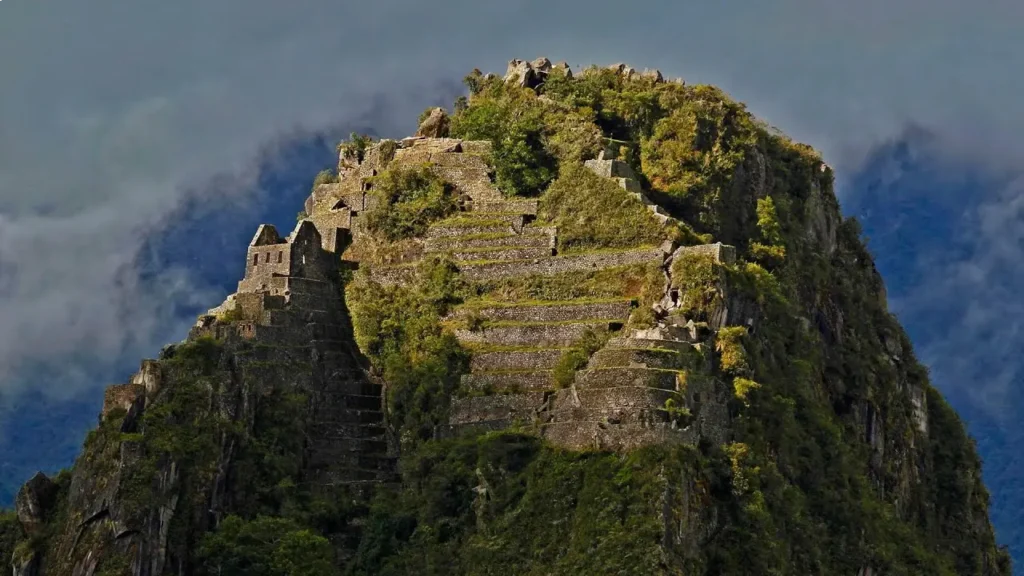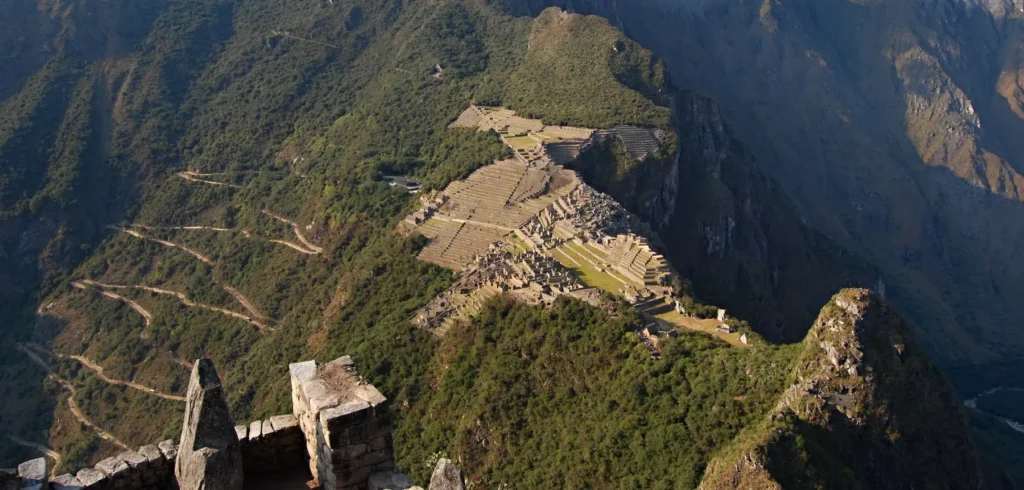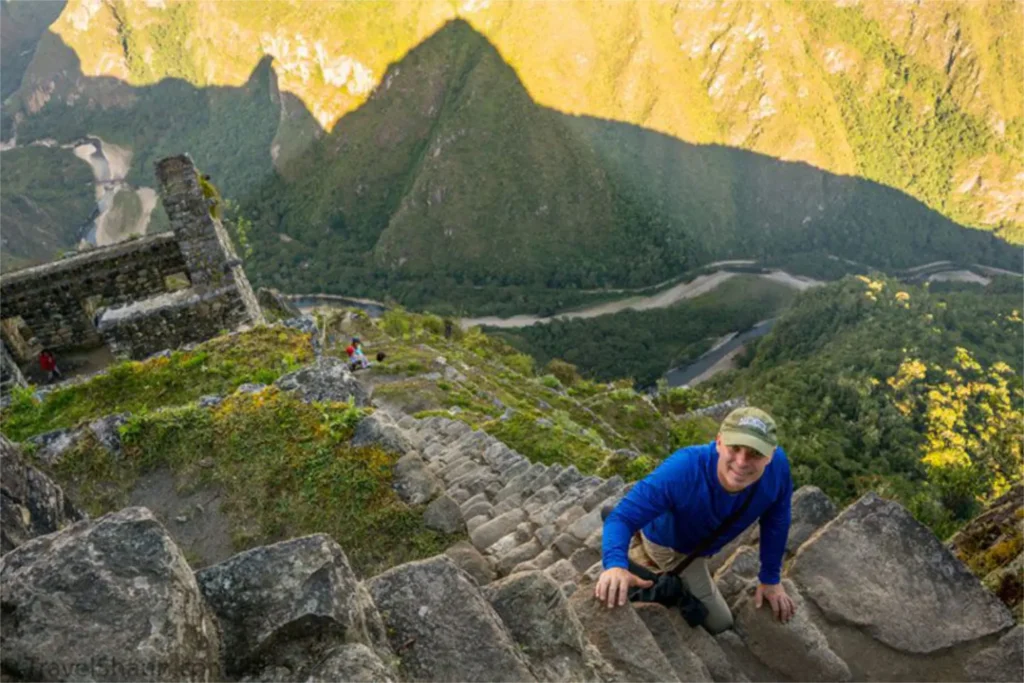Huayna Picchu, the imposing peak that rises north of the citadel of Machu Picchu, is one of the most emblematic and desired experiences for visitors to the Inca heritage. Its iconic silhouette, often photographed from the esplanade of the Temple of the Sun or the Citadel Lookout, dominates the landscape with an almost mystical presence.
More than just a viewpoint, Huayna Picchu represents a link between Inca architecture and Andean spirituality, offering not only spectacular views, but also an archaeological and symbolic journey of great depth. This article explores its history, access, visiting conditions and its importance within the archaeological complex of Machu Picchu.

Huayna Picchu, which in Quechua means “Young Mountain”, is located north of the main citadel of Machu Picchu, separated by a deep cliff that can only be crossed by a series of narrow stairways and footbridges built by the Incas. Unlike Machu Picchu, which sits on a plateau, Huayna Picchu is a steep rock formation, whose summit reaches 2,693 meters above sea level, some 300 meters above the level of the main complex. Its strategic position suggests that it was used as a place of observation, ceremony and territorial control.
Archaeologists have identified a series of structures on its slopes that reveal its ceremonial function. Among them are the Temple of the Moon, a semi-subterranean construction carved in a natural grotto, surrounded by stone terraces and canals, as well as the Eagle’s Lookout, an elevated point that allows a panoramic view of the Urubamba River valley. These spaces, combined with the difficulty of access, indicate that Huayna Picchu was not an area of common residence, but an enclosure reserved for priests, authorities or rituals linked to solar worship and the forces of nature.

The journey to the top
Ascending Huayna Picchu is a demanding experience, both physically and emotionally. The trail, approximately 1.8 kilometers one way, runs mostly on original Inca stairways, many of them carved directly into the living rock. Some sections are narrow, with steep slopes and minimal protection, which requires caution, good physical condition and no vertigo. The complete route, including the descent, lasts between two and three hours, depending on the visitor’s pace.
The trail begins next to the Temple of the Sun, at the northern end of Machu Picchu, and winds through shady passages, narrow tunnels and wooden bridges across deep crevices. As you ascend, the vegetation becomes denser, with giant ferns, wild orchids and mosses covering the stones. The atmosphere, shrouded in morning mists, reinforces the sacredness of the site. At the top, the panorama is breathtaking: Machu Picchu can be seen in its entirety, like a jewel embedded between mountains, with the Urubamba River meandering at its feet.

Access to Huayna Picchu is strictly regulated by the Peruvian Ministry of Culture in order to protect both the archaeological heritage and the safety of visitors. Only 400 entries are allowed daily, divided into three morning shifts. Each shift has a specific entrance schedule, and all visitors must be accompanied by a certified guide. Tickets must be reserved months in advance, especially during the high season (May to October), and cannot be purchased at the park gate.
In addition, there is a recommended visitor profile. Children under 12 years of age, people with heart problems, severe vertigo or physical limitations that prevent them from walking safely on uneven terrain are not allowed. The use of large backpacks, trekking poles or drones is not allowed. The use of helmets is mandatory in certain sections, and failure to comply with the rules may result in expulsion from the site.
Differences from Machu Picchu Mountain
Huayna Picchu is often confused with Machu Picchu Mountain, an adjacent hill located south of the citadel. Although both offer panoramic views, they are different experiences. Machu Picchu Mountain is higher (3,082 meters above sea level), with a longer and more technical ascent, and requires more physical effort. In contrast, Huayna Picchu is shorter, but technically more complex due to its narrow stairways and limited handrails. In addition, Huayna Picchu includes archaeological structures in its route, while Machu Picchu Mountain is mainly a natural viewpoint. Both have limited spaces and must be booked separately.
Conservation and responsible tourism
The fragility of the ecosystem and the age of the structures make Huayna Picchu an especially vulnerable area. Constant visitor traffic, coupled with natural erosion, requires careful management. For this reason, Peruvian authorities have implemented measures such as the temporary closure of trails for maintenance, the installation of handrails in critical areas, and ongoing training of guides in sustainable practices.
For the traveler, respecting the rules is not only a legal obligation, but an act of responsibility. Not touching the structures, not leaving waste, maintaining silence in ceremonial areas and following the guide’s instructions are simple gestures that contribute to the preservation of this unique place. In addition, choosing tour operators certified in sustainability ensures that part of the income is invested in conservation and in the well-being of local communities.
Conclusion
Huayna Picchu is not only a viewpoint, but a transcendental experience within the universe of Machu Picchu. Its ascent combines physical challenge, connection with nature and encounter with Inca spirituality. From its millenary stairways to its temples hidden in the mist, each step reveals the mastery of a civilization that knew how to harmoniously integrate architecture with the sacred landscape.
For those who manage to conquer it, Huayna Picchu offers an incomparable reward: a unique view of the past, and a moment of introspection in front of the greatness of the Andean legacy. However, its access must be planned with responsibility, anticipation and respect. Only in this way will it be possible to preserve this jewel for future generations, keeping alive the essence of a place that, more than a mountain, is a symbol of balance between man and the cosmos.
No comments:
Post a Comment